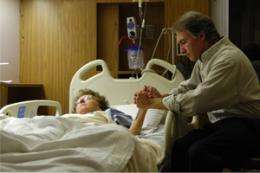Patients with implanted cardiac devices should learn about end-of-life options

An implanted device meant to correct heart rhythm may generate repeated painful shocks during a patient’s final hours, at a time when the natural process of dying often affects the heart’s rhythm. Yet, clinicians rarely discuss options for limiting these distressing events, according to a new review of literature, in the current issue of American Journal of Nursing.
The devices — known as implantable cardioverter defibrillators (ICDs) — can be reprogrammed or deactivated by trained providers to avoid the unnecessary shocks. However, most patients don’t understand enough about the devices to consider stopping treatment as death nears.
Health care systems should “identify ways to promote timely deactivation discussions and thus foster better patient-centered, end-of-life care in people with ICDs,” says author Jim Russo, a certified cardiac device specialist at the Department of Veterans Affairs Medical Center in New York City.
Surgically implanted ICDs have become standard treatment for people at risk for life-threatening heart rhythm problems, with over 140,000 implanted in 2009 alone. The programmable electronic devices can detect an arrhythmia and deliver a painful “kick in the chest” to help the heart regain its normal beat.
The review included 14 studies on how providers and patients handle discussions about limiting the shock function when a patient is near death. Although the studies were small, the results were fairly consistent: Most healthcare providers avoid these discussions, either due to discomfort or lack of information about deactivation or reprogramming options.
“Cardiologists and electrophysiologists have been notoriously poor at talking about end-of-life care,” says David L. Hayes, M.D., an internationally recognized specialist in cardiovascular disease. Hayes is a co-author of the 2010 consensus statement on device withdrawal published by the Heart Rhythm Society. “The discussion about end of life needs to occur at multiple points along the continuum of care,” he says.
“Discussions should occur at implantation and again at periodic follow-up visits,” suggests Russo. “Providers periodically review and discuss advance directives, and that would be a good time to discuss this issue also.”
The review calls for health care services to develop written policies on device deactivation and for stronger alliances among primary care providers, cardiologists, and palliative care experts. Nurses may also have an important role as they are often responsible for patient education and may be the first to recognize when a patient’s condition begins to deteriorate.
Hayes points out that end-of-life issues related to implantable cardiac devices are not going away. “Providers need to get over their reluctance to discuss death and dying. These are issues in this technically advanced world of treating an aging population that we are all going to need to deal with.”
More information: Russo JE. Original Research: Deactivation of ICDs at the End of Life: A Systematic Review of Clinical Practices and Provider and Patient Attitudes. Am J Nurs 2011; 111(10):26-35.

















